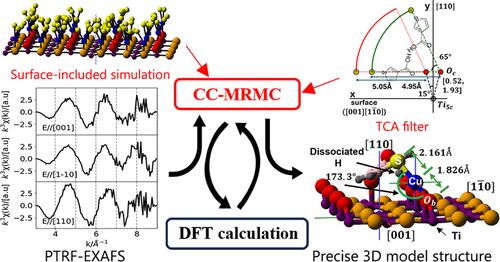3D Precise Structure Determination of Single-Atom Cu Species on TiO2 Using Polarization-Dependent Total Reflection Fluorescent X-ray Absorption Fine Structure Empowered by Chemically Constrained Micro Reverse Monte Carlo and Density Functional Theory
IF 3.2
3区 化学
Q2 CHEMISTRY, PHYSICAL
引用次数: 0
Abstract
We have developed a chemically constrained micro reverse Monte Carlo (CC-MRMC) method and have statistically determined the three-dimensional (3D) structure of single-atom Cu species dispersed on a 3-thiophene carboxylic acid (TCA)-premodified flat single-crystal oxide surface using a polarization-dependent total reflection fluorescent X-ray absorption fine structure (PTRF-XAFS) technique. The CC-MRMC analysis of the PTRF-XAFS data indicated that an S–Cu–O sandwich structure was adsorbed on the TiO2(110) surface at three equivalent sites of TiO2(110). We carried out density functional theory (DFT) calculations to select one structure among the three candidates. The Cu has a linear structure sandwiched with S in TCA and the bridging oxygen (OB) of TiO2. The TCA is adsorbed onto the TiO2(110) surface as a monodentate carboxylate species, CO(–Ti)O–, with a loss of H+. The advantages and disadvantages of the combination of the PTRF-XAFS + CC-MRMC and DFT methods are discussed.

基于化学约束微反蒙特卡罗和密度泛函理论的偏振光全反射荧光x射线吸收精细结构在TiO2上单原子Cu的三维精确结构测定
我们开发了一种化学约束的微反向蒙特卡罗(CC-MRMC)方法,并利用偏振依赖全反射荧光x射线吸收精细结构(PTRF-XAFS)技术统计确定了分散在3-噻吩羧酸(TCA)预修饰的平面单晶氧化物表面上的单原子Cu物种的三维(3D)结构。PTRF-XAFS数据的CC-MRMC分析表明,在TiO2(110)的三个等效位点上,TiO2(110)表面吸附了S-Cu-O夹层结构。我们进行密度泛函理论(DFT)计算,从三个候选结构中选择一个。在TCA和TiO2的桥接氧(OB)中,Cu呈线性结构,夹有S。TCA以CO(- ti)O -单齿羧酸形式吸附在TiO2(110)表面,H+损失。讨论了PTRF-XAFS + CC-MRMC与DFT相结合的优缺点。
本文章由计算机程序翻译,如有差异,请以英文原文为准。
求助全文
约1分钟内获得全文
求助全文
来源期刊

The Journal of Physical Chemistry C
化学-材料科学:综合
CiteScore
6.50
自引率
8.10%
发文量
2047
审稿时长
1.8 months
期刊介绍:
The Journal of Physical Chemistry A/B/C is devoted to reporting new and original experimental and theoretical basic research of interest to physical chemists, biophysical chemists, and chemical physicists.
 求助内容:
求助内容: 应助结果提醒方式:
应助结果提醒方式:


